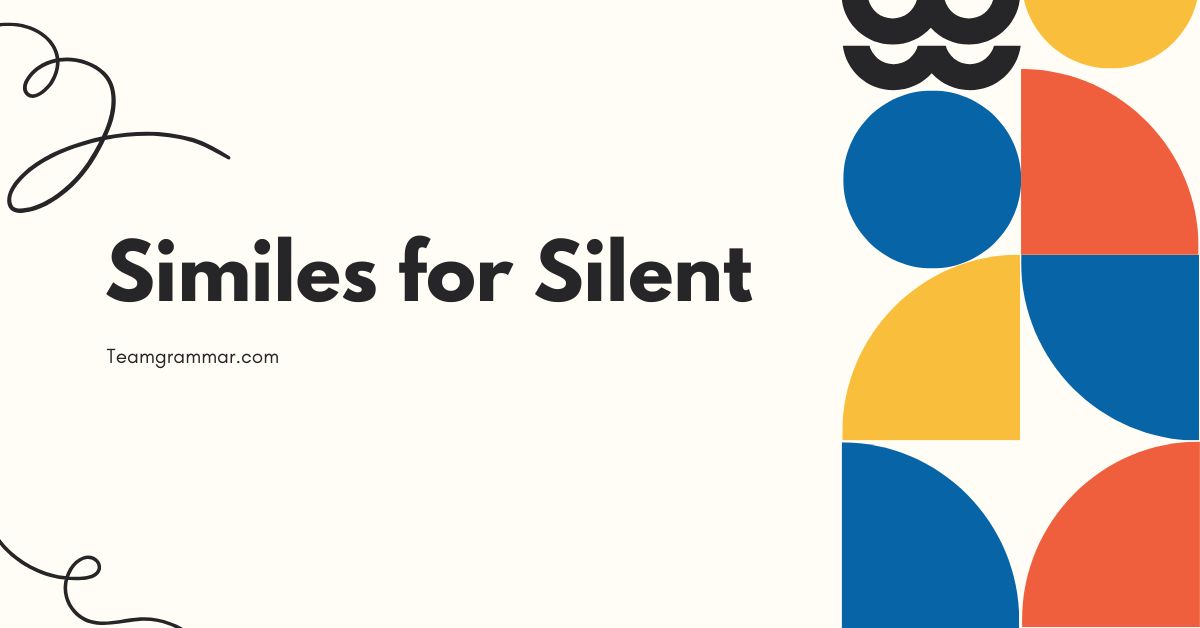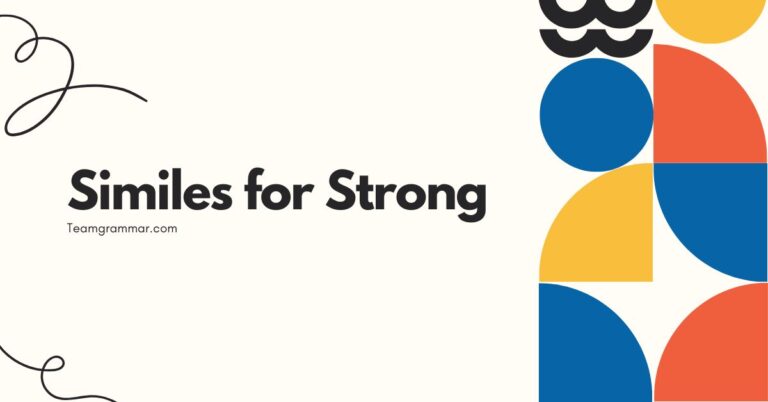28 Similes for Silent: Mastering Figurative Language & Grammar
Understanding similes is crucial for enhancing your writing and comprehension skills. Similes enrich language by creating vivid comparisons, making descriptions more engaging and memorable.
This article provides a comprehensive guide to similes that describe silence, exploring their structure, types, and usage. Whether you are a student, a writer, or simply someone who loves language, this guide will help you master the art of using similes to depict silence effectively and creatively in your writing.
Table of Contents
- Introduction
- Definition of Similes
- Structural Breakdown of Similes
- Types of Similes for Silent
- Examples of Similes for Silent
- Usage Rules for Similes
- Common Mistakes with Similes
- Practice Exercises
- Advanced Topics in Similes
- Frequently Asked Questions (FAQ)
- Conclusion
Definition of Similes
A simile is a figure of speech that compares two unlike things using the words “like” or “as.” The primary function of a simile is to create a vivid and imaginative description by drawing a parallel between two distinct entities. Similes are foundational in descriptive writing, poetry, and everyday conversation, allowing speakers and writers to convey complex ideas in an accessible and relatable manner.
Understanding similes is crucial for both interpreting and creating effective and engaging language.
Similes belong to the broader category of figurative language, which includes metaphors, personification, and hyperbole. Unlike metaphors, which directly equate two things (e.g., “The night is a black cat”), similes suggest a similarity between them (e.g., “The night is like a black cat”).
This distinction makes similes generally easier to identify and understand, especially for language learners. The context in which a simile is used often determines its effectiveness, as a well-chosen simile can significantly enhance the impact of a statement or description.
Classification of Similes
Similes can be classified based on the type of comparison they make. Some similes focus on physical attributes, while others highlight emotional or abstract qualities.
For instance, a simile might compare the silence to a physical object, such as “as still as a statue,” or to an abstract concept, such as “like a secret held close.” The classification depends on the specific elements being compared and the nature of their similarity.
Function of Similes
The primary function of a simile is to enhance understanding and create a vivid mental image. By comparing something unfamiliar to something familiar, similes make abstract concepts more concrete and relatable.
In the context of describing silence, similes can evoke the quality, depth, and impact of silence, helping the audience to experience it more fully. For example, describing silence as “like a heavy blanket” conveys a sense of oppressiveness or completeness.
Contexts for Using Similes
Similes are versatile and can be used in various contexts, including literature, poetry, everyday conversation, and technical writing. In literature and poetry, similes add depth and texture to descriptions, enhancing the reader’s experience.
In everyday conversation, similes make communication more engaging and expressive. Even in technical writing, similes can simplify complex concepts by drawing relatable comparisons.
The key is to use similes judiciously, ensuring they contribute to clarity and impact.
Structural Breakdown of Similes
Similes typically follow a simple structure: **Subject + Linking Word + Object of Comparison**. The subject is the entity being described, the linking word is either “like” or “as,” and the object of comparison is the entity to which the subject is being compared.
Understanding this structure is essential for both identifying and constructing effective similes. The clarity and impact of a simile depend on the appropriateness of the comparison and the precision of the linking word.
The linking words “like” and “as” are interchangeable in many similes, but there can be subtle differences in their usage. “Like” is generally used to indicate a similarity in one or more aspects, while “as” often implies a closer or more direct resemblance.
However, these distinctions are not always strict, and the choice between “like” and “as” often depends on stylistic preference. Consider the following examples: “Silent like the grave” versus “As silent as the grave.” While both convey a similar meaning, the latter might suggest a more profound or absolute silence.
An effective simile requires a clear and logical connection between the subject and the object of comparison. The comparison should highlight a specific quality or characteristic that both entities share.
If the connection is too vague or tenuous, the simile may be confusing or ineffective. For example, comparing silence to a roaring ocean would be illogical because these two concepts have little in common.
A more effective simile might compare silence to the stillness of a deep ocean trench, emphasizing the sense of depth and mystery.
The Subject
The subject of a simile is the thing being described or compared. In the context of this article, the subject is “silent” or “silence.” The subject sets the stage for the comparison and provides the basis for the simile’s meaning.
The subject should be clearly defined so that the comparison is easily understood.
The Linking Word
The linking word, either “like” or “as,” is the bridge that connects the subject and the object of comparison. This word signals that a comparison is being made, rather than a direct equivalence.
The choice between “like” and “as” can subtly affect the tone and emphasis of the simile.
The Object of Comparison
The object of comparison is the thing to which the subject is being compared. This object should have a quality or characteristic that is similar to the subject, creating a meaningful and vivid comparison.
The effectiveness of the simile depends on the appropriateness and clarity of this comparison.
Types of Similes for Silent
Similes for “silent” can be categorized based on the qualities or characteristics they emphasize. These categories include similes that focus on stillness, emptiness, secrecy, and oppressiveness.
Each type conveys a different aspect of silence, allowing for a nuanced and expressive description. Understanding these categories can help writers choose the most effective simile for their intended purpose.
Similes Emphasizing Stillness
These similes compare silence to things that are motionless or inactive, highlighting the absence of sound and movement. Examples include “as still as a statue,” “like a frozen lake,” and “as quiet as a mouse.” These similes evoke a sense of calm and tranquility, emphasizing the lack of disturbance.
Similes Emphasizing Emptiness
These similes compare silence to things that are devoid of content or activity, emphasizing the absence of sound and the feeling of hollowness. Examples include “like an empty room,” “as hollow as a drum,” and “silent as a vacuum.” These similes convey a sense of desolation or isolation, highlighting the lack of any filling sound.
Similes Emphasizing Secrecy
These similes compare silence to things that are hidden or concealed, emphasizing the sense of mystery and unspoken words. Examples include “like a secret held close,” “as guarded as a tomb,” and “silent as a shadow.” These similes evoke a sense of intrigue and suspense, suggesting that something is being deliberately withheld.
Similes Emphasizing Oppressiveness
These similes compare silence to things that are heavy or burdensome, emphasizing the sense of pressure and discomfort. Examples include “like a heavy blanket,” “as thick as fog,” and “silent as a held breath.” These similes convey a sense of tension or unease, highlighting the stifling effect of silence.
Examples of Similes for Silent
The following tables provide numerous examples of similes for “silent,” categorized by the qualities they emphasize. Each example illustrates how a simile can be used to create a vivid and expressive description of silence.
These examples can serve as inspiration for writers and language learners seeking to enhance their descriptive skills.
This first table focuses on similes that describe silence as something still and unmoving. These similes often evoke a sense of peace, tranquility, or even suspense, depending on the context.
| Simile | Explanation |
|---|---|
| As still as a statue | Implies complete lack of movement or sound. |
| Like a frozen lake | Suggests a surface undisturbed and quiet. |
| As quiet as a mouse | Evokes a sense of stealth and unobtrusiveness. |
| Like a sleeping forest | Suggests a deep, natural silence. |
| As hushed as a library | Implies a deliberate suppression of noise. |
| Like a graveyard at midnight | Evokes a sense of eerie stillness. |
| As silent as the grave | Suggests a final, absolute quiet. |
| Like a stone in water | Implies a sinking, enveloping silence. |
| As motionless as a painting | Suggests a captured, eternal silence. |
| Like a paused movie | Implies a temporary cessation of sound. |
| As calm as a windless day | Evokes a sense of serene quietude. |
| Like a world without birds | Suggests an unnatural, unsettling silence. |
| As still as time stood | Implies an eternal, profound silence. |
| Like a shadow in the night | Suggests a quiet, unnoticed presence. |
| As silent as a falling leaf | Evokes a gentle, natural quiet. |
| Like a breath held underwater | Implies a tense, suppressed silence. |
| As quiet as a church mouse | Suggests a humble, unobtrusive silence. |
| Like a secret whispered in the dark | Implies a conspiratorial, hushed silence. |
| As still as a sleeping child | Evokes a peaceful, innocent quiet. |
| Like a snowflake on warm skin | Suggests a fleeting, delicate silence. |
| As silent as a forgotten dream | Implies a lost, irretrievable quiet. |
| Like a heart that no longer beats | Evokes a somber, final silence. |
| As quiet as the eye of a storm | Suggests a deceptive, ominous silence. |
| Like a room after everyone has left | Implies a lonely, echoing silence. |
| As still as a deer in headlights | Evokes a frozen, fearful silence. |
This table presents similes that emphasize the emptiness and lack of sound associated with silence. These similes often convey feelings of loneliness, isolation, or desolation.
| Simile | Explanation |
|---|---|
| Like an empty room | Suggests a lack of activity and sound. |
| As hollow as a drum | Implies a deep, resonating emptiness. |
| Silent as a vacuum | Evokes a sense of complete absence of sound. |
| Like a deserted street | Suggests abandonment and quiet. |
| As barren as a desert | Implies a desolate, lifeless silence. |
| Like a ghost town | Evokes a sense of forgotten emptiness. |
| As empty as a promise | Suggests a void filled with disappointment. |
| Like a heart without love | Implies an emotional emptiness. |
| As hollow as a tree struck by lightning | Suggests a damaged, resonating emptiness. |
| Like a mind without thoughts | Implies a blank, unthinking silence. |
| As empty as a well run dry | Evokes a sense of depletion and loss. |
| Like a stage after the performance | Suggests a quiet aftermath. |
| As barren as the moon | Implies an alien, lifeless silence. |
| Like a house with no laughter | Suggests a joyless, hollow silence. |
| As empty as a politician’s promises | Evokes a cynical, untrustworthy silence. |
| Like a soul without hope | Implies a profound spiritual emptiness. |
| As hollow as a broken dream | Suggests a shattered, resonating emptiness. |
| Like a canvas before the painting | Implies a potential, yet unrealized silence. |
| As empty as space between stars | Evokes a vast, cosmic silence. |
| Like a book with no words | Suggests a lack of content and meaning. |
| As hollow as a broken heart | Implies a deep emotional pain. |
| Like a theater after the audience leaves | Suggests a post-event quiet. |
| As empty as a politician’s speech | Evokes a sense of insincerity. |
| Like a classroom on summer vacation | Implies a lack of activity and sound. |
| As barren as a forgotten garden | Suggests a desolate, neglected quiet. |
This table features similes that highlight the secretive and hidden nature of silence. These similes often create a sense of mystery, suspense, or unspoken tension.
| Simile | Explanation |
|---|---|
| Like a secret held close | Suggests something deliberately concealed. |
| As guarded as a tomb | Implies a protected, impenetrable silence. |
| Silent as a shadow | Evokes a sense of stealth and hidden presence. |
| Like a conspiracy in the dark | Suggests a hushed, secretive plot. |
| As concealed as a buried treasure | Implies a valuable, hidden silence. |
| Like a lie unspoken | Evokes a sense of deception and quiet. |
| As secretive as the night | Suggests a mysterious, hidden silence. |
| Like a thought unexpressed | Implies a potential, yet unspoken silence. |
| As guarded as a fortress | Suggests a protected, impenetrable silence. |
| Like a hidden truth | Evokes a sense of mystery and quiet. |
| As silent as a spy | Suggests a stealthy, secretive presence. |
| Like a confession never made | Implies a suppressed, unspoken silence. |
| As guarded as a secret diary | Suggests a personal, protected silence. |
| Like a truth hidden in plain sight | Evokes a deceptive, quiet presence. |
| As silent as a witness | Suggests a knowing, yet unspoken silence. |
| Like a regret unconfessed | Implies a burdensome, quiet guilt. |
| As secretive as a midnight rendezvous | Suggests a clandestine, hushed meeting. |
| Like a word left unsaid | Implies a missed opportunity for expression. |
| As guarded as a nation’s secrets | Suggests a high-stakes, protected silence. |
| Like a forgotten memory | Evokes a lost, irretrievable quiet. |
| As silent as a conspirator’s meeting | Suggests a hushed, secretive gathering. |
| Like a promise kept hidden | Implies a loyal, protected silence. |
| As secretive as a magician’s trick | Evokes a sense of mystery and deception. |
| Like a feeling left unshown | Implies a suppressed, emotional silence. |
| As guarded as a royal secret | Suggests a high-status, protected silence. |
This table provides examples of similes that emphasize the oppressive and burdensome nature of silence. These similes often convey feelings of tension, discomfort, or unease.
| Simile | Explanation |
|---|---|
| Like a heavy blanket | Suggests a stifling, overwhelming silence. |
| As thick as fog | Implies a dense, impenetrable silence. |
| Silent as a held breath | Evokes a sense of tension and suppression. |
| Like a weight on the chest | Suggests a burdensome, oppressive silence. |
| As stifling as a closed room | Implies a confined, uncomfortable silence. |
| Like a knot in the stomach | Evokes a sense of unease and quiet. |
| As oppressive as a summer heat | Suggests a heavy, uncomfortable silence. |
| Like a dark cloud overhead | Implies an ominous, foreboding quiet. |
| As heavy as a guilty conscience | Suggests a burdensome, regretful silence. |
| Like a pressure in the ears | Evokes a sense of discomfort and tension. |
| As stifling as a gag | Suggests a suppressed, forced silence. |
| Like a lump in the throat | Implies an emotional, choked silence. |
| As oppressive as a tyrant’s rule | Suggests a forced, uncomfortable quiet. |
| Like a shadow looming large | Evokes a sense of fear and quiet. |
| As heavy as a heart full of grief | Suggests a sorrowful, burdensome silence. |
| Like a silence before a storm | Implies a tense, foreboding quiet. |
| As stifling as a lie unspoken | Suggests a suppressed, guilty silence. |
| Like a burden carried alone | Implies a lonely, oppressive quiet. |
| As oppressive as a secret shame | Suggests a hidden, uncomfortable silence. |
| Like a room filled with unspoken words | Evokes a tense, stifled atmosphere. |
| As heavy as a broken promise | Suggests a disappointing, burdensome silence. |
| Like a weight of expectation | Implies a pressured, tense quiet. |
| As stifling as a forced smile | Suggests a fake, uncomfortable silence. |
| Like a room full of unspoken tension | Evokes a strained, uncomfortable atmosphere. |
| As heavy as a heart full of secrets | Suggests a burdened, secretive silence. |
Usage Rules for Similes
Using similes effectively requires understanding certain rules and guidelines. The most important rule is to ensure that the comparison is clear and logical.
The subject and the object of comparison should share a common quality or characteristic that is easily recognizable. Avoid using clichés or overused similes, as they can diminish the impact of your writing.
Instead, strive to create original and imaginative comparisons that surprise and delight the reader.
Another important rule is to consider the context in which the simile is being used. The simile should be appropriate for the tone and style of the writing.
A simile that is too whimsical or fanciful may be out of place in a serious or formal context. Conversely, a simile that is too bland or obvious may not be effective in a creative or imaginative context.
Choose similes that enhance the overall impact of your writing and contribute to its meaning.
Similes should also be used sparingly. Overusing similes can make your writing feel cluttered and artificial.
Instead, use similes strategically to highlight key points and create memorable images. A well-chosen simile can be more effective than a dozen mediocre ones.
Focus on quality over quantity, and use similes only when they truly enhance your writing.
Exceptions to Usage Rules
While the above rules are generally applicable, there are some exceptions. In certain cases, a simile may be intentionally illogical or absurd for comedic or surreal effect.
In such cases, the violation of the rules is deliberate and contributes to the overall artistic purpose. However, these exceptions should be used with caution and only when they are appropriate for the intended audience and context.
Common Mistakes with Similes
One of the most common mistakes with similes is using clichés or overused comparisons. Examples include “as quiet as a mouse” or “as silent as the grave.” While these similes are grammatically correct, they lack originality and impact.
Strive to create fresh and imaginative comparisons that surprise and delight the reader. Consider the following examples:
| Incorrect | Correct |
|---|---|
| As quiet as a mouse | As silent as a shadow creeping across the floor |
| As silent as the grave | As silent as a forgotten tomb |
Another common mistake is using similes that are illogical or nonsensical. The subject and the object of comparison should share a clear and recognizable quality.
Avoid comparing things that have little or nothing in common. For example, comparing silence to a roaring waterfall would be illogical and confusing.
Instead, choose comparisons that are relevant and meaningful. Consider the following examples:
| Incorrect | Correct |
|---|---|
| Silent like a roaring waterfall | Silent like the eye of a hurricane |
| As quiet as a busy city | As quiet as a snow-covered field |
A further mistake is overusing similes, which can make your writing feel cluttered and artificial. Use similes sparingly and strategically to highlight key points and create memorable images.
A well-chosen simile can be more effective than a dozen mediocre ones. Consider the following examples:
| Overuse | Improved |
|---|---|
| The room was silent like a tomb. The air was still as a statue. The shadows were quiet like mice. | The room was silent as a tomb, shadows creeping like mice. |
Practice Exercises
Test your understanding of similes with the following practice exercises. Each exercise includes a series of questions designed to challenge your knowledge and skills.
Answers are provided at the end of each exercise.
Exercise 1: Identifying Similes
Identify the similes in the following sentences:
| Question | Answer |
|---|---|
| 1. The night was as silent as a deep ocean trench. | as silent as a deep ocean trench |
| 2. Her voice was like a gentle breeze. | like a gentle breeze |
| 3. The snow fell silently, like feathers drifting from the sky. | like feathers drifting from the sky |
| 4. He stood as still as a statue, watching the scene unfold. | as still as a statue |
| 5. The room was silent, like an empty theater after the show. | like an empty theater after the show |
| 6. The forest was as quiet as a sleeping giant. | as quiet as a sleeping giant |
| 7. The secret was as guarded as a king’s treasure. | as guarded as a king’s treasure |
| 8. The silence hung in the air like a heavy curtain. | like a heavy curtain |
| 9. The old house stood as silent as a ghost. | as silent as a ghost |
| 10. The words were like a key unlocking a hidden door. | like a key unlocking a hidden door |
Exercise 2: Completing Similes
Complete the following similes with appropriate endings:
| Question | Answer |
|---|---|
| 1. As silent as __________. | As silent as a shadow |
| 2. Like a __________, the room was still. | Like a tomb, the room was still. |
| 3. The night was as quiet as __________. | The night was as quiet as a sleeping village |
| 4. The forest was silent, like __________. | The forest was silent, like a world holding its breath. |
| 5. As still as __________, he waited patiently. | As still as a statue, he waited patiently. |
| 6. The secret was as safe as __________. | The secret was as safe as a locked diary. |
| 7. The house was quiet, like __________. | The house was quiet, like a forgotten memory. |
| 8. As hushed as __________, the library stood. | As hushed as a cathedral, the library stood. |
| 9. The scene was as still as __________. | The scene was as still as a painting. |
| 10. The moment was silent, like __________. | The moment was silent, like a held breath. |
Exercise 3: Creating Similes
Create your own similes to describe the following:
| Topic | Example Simile |
|---|---|
| 1. A silent forest | The forest was as silent as a dream undisturbed. |
| 2. A quiet room | The room was like a bubble of silence, untouched by the outside world. |
| 3. A secret kept | The secret was held as silently as a heartbeat in the night. |
| 4. A still lake | The lake lay as still as glass, reflecting the sky’s serene face. |
| 5. A forgotten place | The town was silent, like a forgotten chapter in history. |
| 6. A sleeping town | The town slept as quietly as a child in its mother’s arms. |
| 7. A hidden truth | The truth was hidden as silently as a star during the day. |
| 8. A waiting moment | The moment hung as silently as a suspended note in music. |
| 9. A lonely night | The night was silent, like a vast, empty canvas. |
| 10. A deep thought | The thought was silent, like a seed buried deep in the earth. |
Advanced Topics in Similes
For advanced learners, exploring the nuances of similes can lead to more sophisticated and creative writing. One advanced topic is the use of extended similes, which involve developing a comparison over several sentences or paragraphs.
This technique allows for a more detailed and nuanced exploration of the similarities between the subject and the object of comparison. Another advanced topic is the use of unconventional or unexpected similes, which can create a sense of surprise and originality.
These similes often involve comparing seemingly unrelated things, challenging the reader’s expectations and creating a fresh perspective.
Another advanced technique involves combining similes with other figures of speech, such as metaphors and personification. This can create a rich and layered effect, adding depth and complexity to your writing.
For example, you might use a simile to introduce a comparison and then develop it further with a metaphor or personification. The key is to use these techniques judiciously and ensure that they contribute to the overall meaning and impact of your writing.
Frequently Asked Questions (FAQ)
- What is the difference between a simile and a metaphor?
A simile is a comparison using “like” or “as,” while a metaphor directly equates two unlike things without using these words. For example, “The night is like a black cat” (simile) versus “The night is a black cat” (metaphor).
- Can a simile be a cliché?
Yes, a simile can become a cliché if it is overused and lacks originality. Common examples include “as quiet as a mouse” or “as silent as the grave.”
- How can I create original similes?
To create original similes, focus on making unexpected connections between dissimilar things. Think about the specific qualities you want to emphasize and look for unique comparisons that capture those qualities. Brainstorming and experimenting with different ideas can help you come up with fresh and imaginative similes.
- Is it better to use “like” or “as” in a simile?
Both “like” and “as” can be used effectively in similes. “Like” is generally used to indicate a similarity in one or more aspects, while “as” often implies a closer or more direct resemblance. However, the choice often depends on stylistic preference and the specific context.
- Can a simile be used in formal writing?
Yes, similes can be used in formal writing, but they should be used judiciously and appropriately. Choose similes that enhance the clarity and impact of your writing without being too informal or whimsical.
- How many similes should I use in a piece of writing?
There is no fixed number, but it’s best to use similes sparingly. Overusing similes can make your writing feel cluttered and artificial. Focus on quality over quantity, and use similes only when they truly enhance your writing.
- What if my simile doesn’t make sense to the reader?
If your simile is confusing or unclear, it may be too abstract or illogical. Ensure that the subject and the object of comparison share a clear and recognizable quality. Test your similes on others to get feedback on their clarity and effectiveness.
- Can similes be used in technical writing?
Yes, similes can be used in technical writing to simplify complex concepts and make them more relatable. However, they should be used with caution and should not compromise the accuracy or objectivity of the writing.
- Are there any cultural considerations when using similes?
Yes, cultural considerations are important when using similes. Some comparisons may be more meaningful or relevant to certain cultures than others. Be mindful of your audience and choose similes that are likely to be understood and appreciated by them.
- How do I avoid using cliché similes?
The key to avoiding cliché similes is to think beyond the obvious. Instead of using the first comparison that comes to mind, brainstorm a variety of options and choose the one that is most original and effective. Reading widely and exposing yourself to different styles of writing can also help you develop a more creative and imaginative approach to similes.
Conclusion
Mastering similes is an essential step in enhancing your writing and communication skills. By understanding the structure, types, and usage rules of similes, you can create vivid and engaging descriptions that captivate your audience.
Remember to avoid clichés, use similes sparingly, and ensure that your comparisons are clear and logical. With practice and attention to detail, you can harness the power of similes to express your ideas more effectively and creatively.
As you continue to develop your skills with similes, experiment with different techniques and approaches. Explore the
like extended similes, unconventional comparisons, and combinations with other figures of speech.
Pay attention to the context in which you are writing and choose similes that are appropriate for your intended audience and purpose. By embracing these challenges and opportunities, you can unlock the full potential of similes and elevate your writing to new heights.







